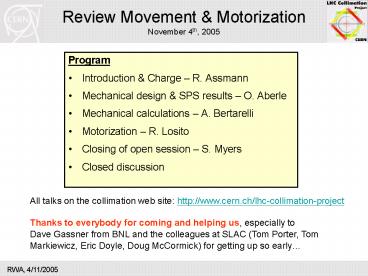Review Movement PowerPoint PPT Presentation
Title: Review Movement
1
Review Movement MotorizationNovember 4th, 2005
- Program
- Introduction Charge R. Assmann
- Mechanical design SPS results O. Aberle
- Mechanical calculations A. Bertarelli
- Motorization R. Losito
- Closing of open session S. Myers
- Closed discussion
All talks on the collimation web site
http//www.cern.ch/lhc-collimation-project
Thanks to everybody for coming and helping us,
especially to Dave Gassner from BNL and the
colleagues at SLAC (Tom Porter, Tom Markiewicz,
Eric Doyle, Doug McCormick) for getting up so
early
2
Why this review?
- Collimation is so critical for the success of the
LHC that we are always trying to get advise on
important decisions. - 07/2004 External review of the full collimation
project. At this time still LEP solution for
motorization. No review possible on movement and
motorization. - Planned Another full review of the collimation
project once first series collimators arrive
(next spring). - Decision to do a special review on movement and
motorization - Decision required on procurement of stepping
motors (decide before next week). High risk 555
motors, 1.5 MCHF, reliability risk for the LHC. - Take maximum time to understand and solve the
problems. Then present status and take a
decision! - We must take some risk because not everything can
be tested in the available time.
3
Why are motors critical?
- Some general collimation challenges for the LHC
- Small beam size at the collimators 200 mm
- Small collimator gaps down to 2 mm in standard
operation and down to 1 mm in special low
emittance conditions - High damage potential of the beams.
- Large fraction (50) of 106 collimators must
respect set-up tolerances around 20-40 mm at 7
TeV. Lengthy set-up! - Excellent reproducibility of jaw settings
required for reestablishing reference settings
without new set-up! - Hostile conditions of the LHC cleaning insertions
(MGy/y dose rates, heating from beam losses or
bake-out, elevated levels of Ozone, ). - 106 installed phase 1 collimators will be driven
with 466 stepping motors. Worry about precision,
reproducibility and reliability. - Much effort has been put on the design of a
precise and fail-safe mechanical movement system.
- The system has been made fail-safe by including
the feature of auto-retraction the jaws are
opened by mechanical springs in case of motor
failures. - Auto-retraction of jaws will in most cases allow
LHC operation to continue and to repair the
problem during a planned intervention period.
This is possible with the built-in redundancy in
the collimation system (2 opposite jaws).
4
Decisions on movement motorization have direct
consequences for
- Operational efficiency of the LHC
- Possibly we must exchange a whole collimator if a
motor fails (takes 1-2 weeks including bake-out). - High number of motors requires high reliability.
- Problems in reproducibility will require retuning
of collimator during each fill (loose time while
not achieving best possible performance). - Architecture of the control system
- For reasons of simplicity we avoid feedback on
motor commands during the movement based on read
positions. - Position read-out is just a check for rare
problems which would always lead to a beam dump. - Schedule
- More studies and tests would lead to delays
(install motors a posteriori, limited hardware
commissioning, ). - ? Panel members selected to advise also on these
risks!
5
Scope
6
Specifications
7
Project proposal
- The members of the collimation project have
agreed on a common proposal, based on our present
knowledge - Go ahead with the procurement of the 555 motors,
as specified. - Do not increase detent torque beyond the
specified 80 N mm but compromise on the maximum
torque at the 20 level, if required. - Accept the risk that auto-retraction does not
fully work in a few collimators but we expect it
works in most. - Take care of proper matching of mechanical system
and motor during series production. - This agreement is the result of hard and
excellent work of all involved, making the system
work in the lab over the last 4 weeksO.
Aberle, R. Losito, R. Chamizo, A. Masi, P.
Gander, A. Bertarelli, R. Perret, - Thanks to them and collaborators for their
impressive efforts!
8
Charge to the reviewers
- The movement and the motorization for the LHC
collimators shall be reviewed - Review the specifications and the achieved
results of collimator motion for the various
types of collimators and the various collimator
orientations. - Assess the overall status of the collimator
mechanical actuation system and possible risks. - Based on the above assessment, advice on the
procurement of the LHC stepping motors. - The decision on motor procurement (1.5 MCHF)
is time critical as we are planning to go to the
December CERN Finance Committee for approval of
the contract. Alternatively we can opt for the
Finance Committee in March, inducing a delay in
motor installation on many collimators (many
collimators will be installed into the tunnel
without motors). Any further delay would not be
possible.

